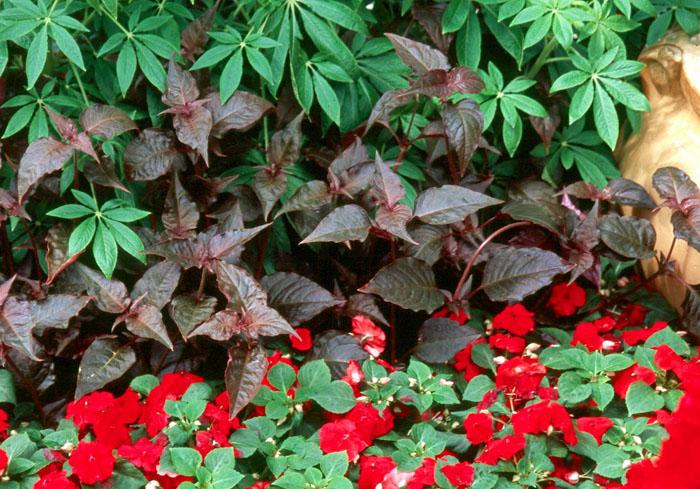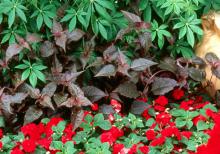Information Possibly Outdated
The information presented on this page was originally released on July 28, 2005. It may not be outdated, but please search our site for more current information. If you plan to quote or reference this information in a publication, please check with the Extension specialist or author before proceeding.
Old, new Joseph's coats yield rainbow of colors
By Norman Winter
MSU Horticulturist
Central Mississippi Research & Extension Center
No matter where you go in the South right now, the plant that seems to be in a constant state of standout performance is the alternanthera, or Joseph's Coat.
Of course, most of the Joseph's Coats we see are the lime green selections usually partnered with coleus or cannas. They are doing quite well at my house even though there is a baby cottontail trimming them for me nightly.
The plant we think of as the traditional Joseph's Coat is known botanically as Alternanthera ficoidia and is native to Mexico and Brazil. The new, taller version is Alternanthera dentata, which is native to the West Indies. Both are related to celosia and gomphrena.
From late spring until frost, this Joseph's Coat-like plant performs admirably in the garden, making it a favorite of home horticulturists and commercial landscapers. In fertile, well-drained soil, it is a problem-free plant.
Alternanthera thrives in full sun with fertile, loamy, well-drained soil. If this doesn't describe your soil, add 3 to 4 inches of organic matter and till to a depth of 8 to 10 inches.
While tilling, incorporate 2 pounds of a slow-release, 12-6-6 fertilizer with micronutrients for each 100 square feet of bed space. Set out nursery-grown transplants 6 to 10 inches apart in late spring.
The alternanthera looks its best if kept sheared or pinched, which keeps it bushy and compact. These troopers are in the ground a long time, so water them during periods of drought and feed with a light application of the fertilizer three times during the summer and early fall.
In my mind, they are superb in the tropical-style garden. Try growing in a tropical bed with bananas, elephant ears, cannas, impatiens and coleus. By all means, try combining with the different varieties of Joseph's Coats.
The plants we think of as traditional Joseph's Coats are often sold generically, but there are more named varieties than you ever imagined. A trip to Disneyworld will show you this plant is indeed escalating in popularity. A few of the leading varieties to look for are Filigree, Magnifica, Parrot Feather, Tricolor and Versicolor. Really hot are the thread-leafed varieties Gold Thread and Red Thread.
Keep your eyes open for newly released varieties like the multi-colored Partytime with green, pink and cream; the green and white Crème de Menthe; the reddish-burgundy Grenadine; and the dark-purple Cognac. You may have to wait until next spring for these.
Examples of the new, larger Joseph's Coats are Purple Knight, this year's Mississippi Medallion award winner, and a similar version called Gail's Choice. Also look for the brilliant-colored Red Marble that reaches 24 to 36 inches in height.
Joseph's Coats are easy to root by cutting. Strip the leaves from the bottom of a 6-inch cutting and place in moist sand or peat with at least one set of leaves above the soil.
Many garden centers still offer large, high-quality plants this time of the year. Plant them now and you will have weeks of brilliant color.








